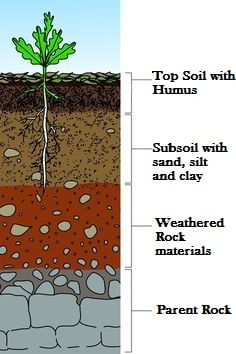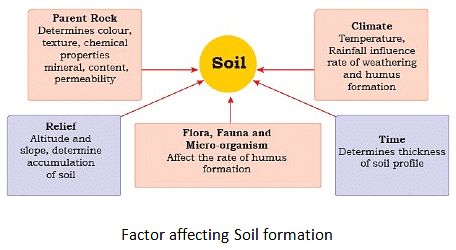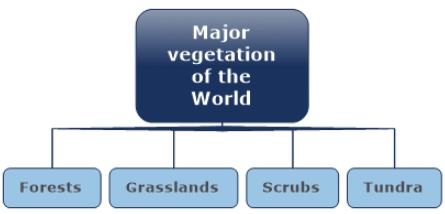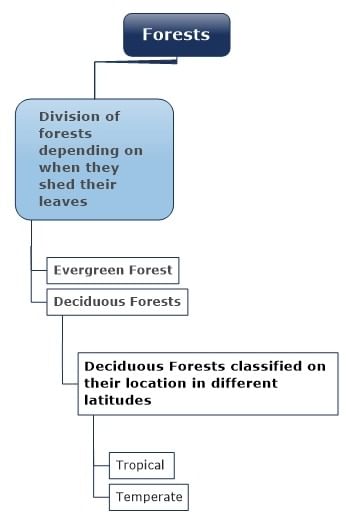Class 8 Exam > Class 8 Notes > Social Studies (SST) Class 8 > NCERT Summary: Land, Soil, Water, Natural Vegetation & Wildlife Resources
Land, Soil, Water, Natural Vegetation & Wildlife Resources Summary Class 8 NCERT Summary Chapter 1
Introduction
- Natural Resources are anything that people can use which comes from nature such as land, water, air etc
Land
- One of the most important natural resources
- Covers about thirty percent of the total area of the earth’s surface, however all parts are not habitable.
- The reason behind uneven distribution of population in different parts of the world is mainly due to varied characteristics of land and climate.
- Areas which are normally sparsely populated or uninhabited: rugged topography, steep slopes of the mountains, low-lying areas susceptible to water logging, desert areas, thick forested areas.
- Areas which are densely populated: Plains and river valleys offer suitable land for agriculture.
Land Use
- The different purpose such as agriculture, forestry, mining, building houses, roads and setting up of industries for which land is used is known as land Use.
- The factors that determine use of land are:
- Topography
- Soil
- Climate
- Minerals
- Availability of water
- Important determinants of land use pattern:
- Human factors such as population
- Technology
- Land Division on the basis of private land and community land:
- Private land is owned by individuals
- Community land is owned by the community for common uses like collection of fodder, fruits, nuts or medicinal herbs. Also called common property resources.
- Population and demands are increasing but land is limited. Many constructional activities are going on also agricultural land is expanding. These are leading to land degradation, landslides, soil erosion, desertification which are major threats to the environment.
Conservation of Land Resources
- Causes of degradation of land resources: Large scale destruction of forest cover and fertile land due to increasing demand.
- How to check present rate of degradation of land resources:
- Afforestation
- Land reclamation
- Regulated use of chemical pesticide and fertilisers
- Checks on overgrazing
Soil
- Definition: The thin layer of grainy substance covering the surface of the earth is called soil.
- Soil is made up of organic matter, minerals and weathered rocks found on the earth. Landforms determine the type of soil.
- The right mix of minerals and organic matter make the soil fertile.

Factors of Soil Formation
- Major Factors:
- Nature of the parent rock
- Climate
- Other Factors:
- Topography
- Role of organic material
- Time
Below chart (from NCERT Book) explain the various factors of soil formation:

Degradation of Soil
- Soil erosion and depletion are the major threats to soil as a resource.
- Factors for soil degradation:
- Deforestation
- Overgrazing
- Overuse of chemical fertilisers or pesticides
- Rain wash
- Landslides
- Floods.
Soil Conservation
- Methods of Soil conservation
- Mulching: The uncovered ground between plants is covered with a layer of organic matter like straw. Helps in retaining soil moisture.

- Contour barriers: Stones, grass, soil are used to build barriers along contours. Trenches(Channels) are made in front of the barriers to collect water.
- Rock dam: Rocks are piled up to slow down the flow of water. This prevents gullies and further soil loss.
- Terrace farming: Terraces are developed on the steep slopes so that flat surfaces are available to grow crops which helps in reducing surface run-off and soil erosion.
- Intercropping: Different crops are grown in alternate rows and are sown at different times to protect the soil from rain wash.
- Contour ploughing: Ploughing parallel to the contours of a hill slope to form a natural barrier for water to flow down the slope.
- Shelter belts: In the coastal and dry regions, rows of trees are planted to check the wind movement to protect soil cover.
- Mulching: The uncovered ground between plants is covered with a layer of organic matter like straw. Helps in retaining soil moisture.
Water
- Important and renewable resource.
- Three-Fourth's of earth's surface is covered with water, therefore the earth is called 'water planet'.
- Ocean cover two-thirds of the earth’s surface whose water is saline and not fit for human consumption.
- Fresh water accounts for only about 2.7 percent from which 70 percent occurs as ice sheets and glaciers in Antarctica, Greenland and mountain regions which are inaccessible.
- Only 1 percent of freshwater is available and fit for human use which is found as ground water, as surface water in rivers and lakes and as water vapour in the atmosphere.
- Fresh water is therefore, the most precious substance on earth as Water can neither be added nor subtracted from the earth.
- An abundance of water only seems to vary because it is in constant motion, cycling through the oceans, the air, the land and back again, through the processes of evaporation, precipitation and run-off. This is known as Water Cycle.
- Use of water by Humans: not only for drinking and washing but also for agriculture, industries, generating electricity through reservoirs of dams are the other usages.
- Factors responsible for shortages in supply of fresh water:
- Increasing population
- Rising demands for food and cash crops
- Increasing urbanisation
- Rising standards of living
These leads to either drying up of water sources or water pollution.
Problems of Water Availability
- Areas facing shortages in fresh water supply: Most of Africa, West Asia, South Asia, parts of western USA, north-west Mexico, parts of South America and entire Australia.
- Water shortage may be a result of variation in seasonal or annual precipitation or the scarcity is caused by over-exploitation and contamination of water sources.
Conservation of Water resources
- Major Contaminants: Discharge of untreated or partially treated sewage, agricultural chemicals and industrial effluents in water bodies.
- How to control Water pollution:
- Forest and other vegetation slow the surface runoff and replenish underground water.
- Water harvesting also save surface runoff.
- The canals should be properly lined to minimise losses by water seepage.
- Using of sprinklers effectively irrigate the area by checking water losses through seepage and evaporation. In dry regions with high rates of evaporation, drip or trickle irrigation is very useful.
Natural Vegetation and Wildlife
- The narrow zone of contact between the lithosphere, hydrosphere and atmosphere where natural vegetation and wildlife exist is called Biosphere.
- Ecosystem is a network of interactions among organisms, and between organisms and their environment living in a specific space.
- Usefulness of Plants:
- Provide timber
- Give shelter to animals
- Produce oxygen we breathe
- Protects soils so essential for growing crops
- Act as shelter belts
- Help in storage of underground water,
- Provide us fruits, nuts, latex, turpentine oil, gum, medicinal plants and also the paper.
- Wildlife includes animals, birds, insects as well as the aquatic life forms.
- Usefulness of Wildlife:
- Provide us milk, meat, hides and wool.
- Insects like bees provide honey
- Help in pollination of flowers
- Play important role as decomposers in the ecosystem.
- Birds feed on insects and act as decomposers as well.
- Vulture due to its ability to feed on dead livestock is a scavenger and considered a vital cleanser of the environment.
Distribution of Natural Vegetation
- The growth of vegetation depends primarily on temperature and moisture.

- Major vegetation types of the world:
- Forests
- Grasslands
- Scrubs
- Tundra
- Heavy rainfall = Huge Trees. Forests flourish in the areas having abundant water supply.
- As the amount of moisture decreases the size of trees and their density reduces.
- In the regions of moderate rainfall short stunted trees and grasses grow forming the grasslands of the world.
- In dry areas of low rainfall, thorny shrubs and scrubs grow which have deep roots and leaves have thorny and waxy surface to reduce loss of moisture by transpiration.
- Tundra vegetation of cold Polar Regions comprise of mosses and lichens.

- Division of forests depending on when they shed their leaves:
- Evergreen forests: do not shed their leaves simultaneously in any season of the year.
- Deciduous forests shed their leaves in a particular season to conserve loss of moisture through transpiration.
- Deciduous Forests further classified on their location in different latitudes.
- Tropical
- Temperate
- Forest cover all over the world is vanishing rapidly.
Conservation of Natural Vegetation and Wildlife
- Plants give shelter to the animals and together they maintain the ecosystem.
- Changes of climate and human interferences can cause the loss of natural habitats for the plants and animals.
- Many species have become vulnerable or endangered and some are on the verge of extinction.
- Factors (Natural and Man-made) responsible for the process of extinction of great natural resources:
- Deforestation
- Soil erosion
- Constructional activities
- Forest fires
- Tsunami and landslides
- Poaching activities are also increasing that result in a sharp decline in the number of particular species. The animals are poached for collection and illegal trade of hides, skins, nails, teeth, horns as well as feathers.
- Some animals who are poached: Tiger, lion, elephant, deer, black buck, crocodile, rhinoceros, snow leopard, ostrich and peacock.
- Measures for Natural Vegetation and Wildlife:
- National parks, wildlife sanctuaries, biosphere reserves are made to protect our natural vegetation and wildlife.
- Conservation of creeks, lakes, and wetlands is necessary to save the precious resource from depletion.
- Awareness programmes like social forestry and Vanamohatasava should be encouraged at the regional and community level.
- School children should be encouraged for bird watching and visiting nature camps so that they appreciate the habitat of varied species.
- Killing and Hunting of birds and animals should be banned.
- In India, killing of lions, tigers, deers, great Indian bustards and peacocks have been banned.
- An international convention CITES has been established that lists several species of animals and birds in which trade is prohibited.
Glossary
- Weathering: The breaking up and decay of exposed rocks, by temperature changes, frost action, plants, animals and man.
- National Park: A natural area designated to protect the ecological integrity of one or more ecosystems for present and future generations.
The document Land, Soil, Water, Natural Vegetation & Wildlife Resources Summary Class 8 NCERT Summary Chapter 1 is a part of the Class 8 Course Social Studies (SST) Class 8.
All you need of Class 8 at this link: Class 8
|
69 videos|431 docs|46 tests
|
FAQs on Land, Soil, Water, Natural Vegetation & Wildlife Resources Summary Class 8 NCERT Summary Chapter 1
| 1. What are some natural resources that are covered in the NCERT summary on Land, Soil, Water, Natural Vegetation & Wildlife Resources? |  |
Ans. The NCERT summary covers various natural resources such as land, soil, water, natural vegetation, and wildlife resources.
| 2. What is the importance of land in relation to natural resources? |  |
Ans. Land is a crucial natural resource as it provides a physical base for various activities like agriculture, settlement, industries, and transportation.
| 3. How does the NCERT summary describe the significance of water as a natural resource? |  |
Ans. The NCERT summary highlights the importance of water as a vital natural resource for various purposes like drinking, irrigation, industries, and hydroelectric power generation.
| 4. What does the NCERT summary say about the role of natural vegetation in maintaining ecological balance? |  |
Ans. According to the NCERT summary, natural vegetation plays a crucial role in maintaining the ecological balance by preventing soil erosion, conserving water, providing habitats for wildlife, and contributing to the overall biodiversity.
| 5. How does the NCERT summary explain the importance of wildlife resources? |  |
Ans. The NCERT summary emphasizes the significance of wildlife resources in terms of ecological balance, conservation of biodiversity, scientific research, tourism, and their contribution to the overall well-being of the planet.
Related Searches
















